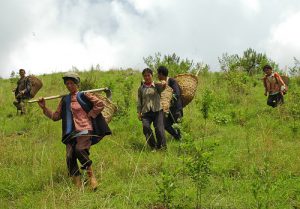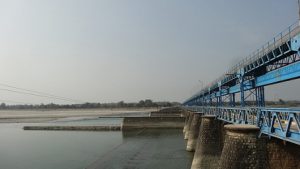Large scale die-backs are happening in all three of the shelterbelts (rows of trees) designed to protect Beijing from sandstorms.
Work on these, in the north-west, north and north-east of China, started in 1978. They were planned to last for 73 years, cover an area of 4.069 million square kilometers (42.4% of China’s total territory) and to surpass Roosevelt’s Great Plains Shelterbelt and Stalin’s Great Plan for the Transformation of Nature. This was to be China’s “Green Great Wall”.
chinadialogue (CD): When poplars were planted did anyone work out when replanting would be necessary and why it was chosen in the first place?
Hou Yuanzhao (Hou): There are different types of poplars, with different lifespans. Those grown from cuttings will usually die off after 30 or 40 years. Trees grown from seeds are recorded to have lived past 800 years in Europe. One in Hainan is 300 years old and still flourishing. Generally they’ll live for over a century. But those grown artificially only last a few decades. And that’s how all the trees in China’s shelterbelt were grown. And that’s why those trees tend to be small and die young.
I think the poplar was chosen because it’s easy to grow, it grows quickly, and at the time there weren’t any trees there at all – anything was an improvement. And they wanted to see quick results. Plus they didn’t know any better, nobody knew how to plant a shelterbelt, and if anyone did know nobody would listen to them. And these were very poor areas back then – there was more interest in a quick profit than in science.
Desertification used to be a real problem in Shiyu county in Shanxi province – the sand could bury a house overnight. Other species would struggle to survive there, but the poplar can cope with being buried in sand, so the township heads all wanted to use poplars. Now it’s all green. But if they don’t quickly move to something more natural for the environment there, things could quickly go bad.
They would have known the poplars would need to be replaced. But who in China thinks 30 or 40 years ahead? "I’ll plant them now and I’ve done my job. If they die in five years – that’s someone else’s problem."
CD: Why hasn’t there been a process of felling and replanting?
Hou: They had to know the trees had a certain lifespan, and they must have known they’d need to be replaced. But in the late 1990s there was a movement to protect China’s forests. And that was needed, and it did a lot of good, but it went to extremes. Even timber plantations couldn’t be felled, much less the shelterbelt. Nobody would have dared to start felling there.
In Shaanxi province I saw a planted pine forest which had also died – the bark just peeled off at a touch. I asked why they hadn’t cut them down, and the locals just said nobody dared. Many of the local cadres have grown up in a time of strict forest protection.
CD: The state has spent huge amounts on tree planting, but are the trees managed once they’re in the ground? Why is nothing being done now the trees are dying?
Hou: For a long time a big problem with China’s forestry policy was that it was all about planting trees, not managing them. And a lot of people still think like that, you just plant a lot of trees and nature will give you a forest. That’s an idea that came from the Soviet Union. In Siberia that works, you can cut down great big swathes of forest and it’ll grow back. But they’ve got better conditions there – the rainfall, the soil, trees to provide seeds, animals to move the seeds around – it’s a forest environment. And most importantly they’ve got enough space to let the forests grow at their own pace.
It’s different in Europe. Historically, after countries like France and Germany felled their forests, they replanted them artificially. But Germany made similar mistakes to China and didn’t change to a more natural method until the 1960s. Currently thinking in China is similar to that in Germany in the latter half of the 19th century – everyone wants a quick return or a quick profit. And that’s not necessarily a mistake, a poor household or a poor country is under more time pressure.
You asked why something wasn’t being done. I think it’s that hands are tied by poor policy, and that there isn’t the money. But if the shelterbelt continues to be managed like this the problems will get worse the more is planted.
CD: Are there similar dangers in other parts of the country?
Hou: Yes, such as north of Chengde and Bashang, in Hebei province and Baxia, in Fujian province, where too many larch have been planted. Saihanba Forest, in Chengde, is held up as a model, but it’s basically a powerkeg. One spark could send over 66,000 hectares of shelterbelt up in flames. But top politicians go and praise it. They say they’re going to plant four more! We invited European forestry expert Heinrich Speicker over to see it. He just shook his head and said it was frightening.
In a sandy place like this it’s a miracle you can grow any forest. And I don’t want to speak against that spirit, just the type of artificial forest that is being created.
CD: Are there any better examples, from China or overseas, we can look to? Can these problems be solved?
Hou: International experience is plain: take the natural path, use the power of nature to restore or expand forest vegetation. The shelterbelts might have been even more effective in this case. The sea-buckthorn, a shrub native to these areas, was being eliminated as a pest in the 1980s. Its roots are hard to clear out, and new plants sprout from anything that’s left behind. But that’s a great thing! Couldn’t we have used that to quickly expand vegetation? But instead everyone was mobilised to eliminate it.
In the mid-80s I researched how they used this plant in the Soviet Union, and what economic and environmental value it had in China. I wrote a report to the director of the Party General Office, Xi Zhongxun, and he was very interested, the report was passed about at a high level. Over the next five or six years there was a constant stream of people from the Chinese Academy of Forestry coming to learn about sea-buckthorn.
It was a complete turnaround, you couldn’t even find the seeds to buy. Qian Zhengying, the Minister for Water Resources, set up a Sea-buckthorn Office, with Niu Maosheng in charge, planting it on Yellow River dykes. It’s a big industry now, mixed sea-buckthorn and poplar forests are moister and retain more soil, as well as reducing pests. And that plant was there all along, I just had to restore its natural place – just like China did with the sparrow, it used to be seen as a pest too.
The shelterbelt can be successful. We’ve got plenty of good ideas, good technology, good species. The problem is too much reliance on the poplar in the north, and the fir in the south. And now as well the eucalyptus and the larch. People just want to plant those trees, what can you do!?







